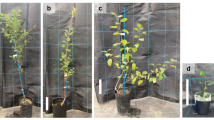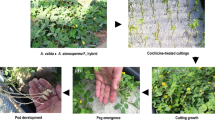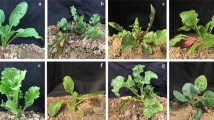Abstract
The wild tetraploid (2n=28) oat species Avena magna and A. murphyi have been domesticated by having been transferred from the common oat, A sativa (2n=42), the characteristics of non-shedding spikelets glabrous and yellow lemma, and reduced awn formation. Domestication has been achieved by crossing the common oat with either of the tetraploid species and then backcrossing the pentaploid hybrids with pollen of the tetraploid wild parent. Among the BC plants obtained only a few produced some seeds. Fertile tetraploids exhibiting the domesticated syndrome have been selected for in the F2 generation. Although morphologically they were almost indistinguishable from the common oat, they were tetraploids. Wild x domesticated A. magna hybrids were vigorous and fertile. They retained their spikelets at maturity, lemma color and pubescence were intermediate between the parental lines, and awns were formed only on the lower floret of the spikelet. Each of these characteristics segregated in a 3∶1 fashion, indicating single gene control, as in the common oat. These four characteristics formed a linkage group in one F2 family and two linkage groups in the other two families. The usefulness of the domesticated tetraploids for oat research and production has been discussed. Taxonomically, the domesticated tetraploids were ranked as subspecies: A. magna ssp. domestica, and A. murphyi ssp. rigida.
Similar content being viewed by others
References
Baum BR (1977) Oats: wild and cultivated. Print Publ Suppl Serv, Ottawa, Canada
Gladstones JS (1967) Selection for economic characteristics in Lupinus angustifolius and L. digitatus. Aust J Exp Agric Anim Husb 7:360–366
International Code of Botanical Nomenclature (1983) Bohn, Scheltema & Holkema, Utrecht
Marshall HG, Shanar GE (1992) Genetics and inheritance in oat. In: Marshal HG, Sorrells ME (eds) Oat science and technology. Am Soc Agron, Madison Wis, pp 510–571
Murphy HC, Sadanaga K, Zillinsky FJ, Terrell EE, Smith RT (1968) Avena magna:An important new tetraploid species of oats. Science 159:103–104
Ladizinsky G (1971) Avena murphyi:a new tetraploid species of oat from southern Spain. Isr J Bot 20:24–27
Ladizinsky G (1992) Genetic resources of tetraploid wild oats and their iutilization. In: Proc 4th Int Oat Conf, vol 2. Adelaide pp 65–70
Ladizinsky G (1993) The taxonomic status of Avena magna:rerappraisal. Lagascalia 17:83–85
Ladizinsky G (1995) Characterization of the missing diploid progenitors of the common oat. Genet Resources Crop Evol 42:49–55
Ladizinsky G, Fainstein R (1977) Introgression between the cultivated hexaploid oat Avena sativa and the tetraploid wild oats A. magna and A. murphyi. Can J Genet Cytol 19:59–66
Schwanitz F (1966) The origin of cultivated plants. Harvard University Press, Cambridge
Suiter KA, Wendel JF, Case JS (1983) LINKAGE-1: a PASCAL progoram for detection and analysis of genetic linkage. J Hered 74:203–204
Author information
Authors and Affiliations
Additional information
Communicated by G. Wenzel
Rights and permissions
About this article
Cite this article
Ladizinsky, G. Domestication via hybridization of the wild tetraploid oats Avena magna and A. murphyi . Theoret. Appl. Genetics 91, 639–646 (1995). https://doi.org/10.1007/BF00223291
Received:
Accepted:
Issue Date:
DOI: https://doi.org/10.1007/BF00223291




